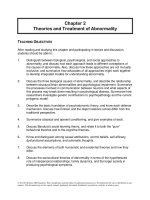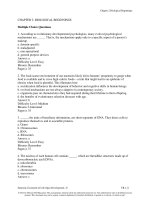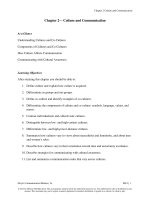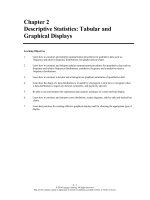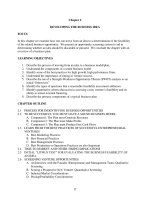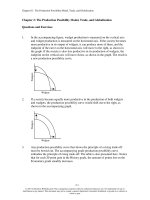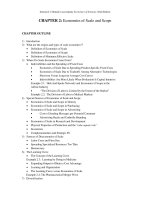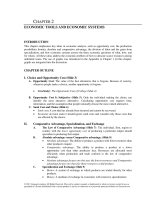Test bank and solution abnomal psychology ch02 (2)
Bạn đang xem bản rút gọn của tài liệu. Xem và tải ngay bản đầy đủ của tài liệu tại đây (446.38 KB, 12 trang )
Chapter 2
Theories and Treatment of Abnormality
TEACHING OBJECTIVES
After reading and studying this chapter and participating in lecture and discussion,
students should be able to:
1.
Distinguish between biological, psychological, and social approaches to
abnormality, and discuss how each approach leads to different conceptions of
the causes of abnormality. Also, discuss how these approaches are not mutually
exclusive, and summarize how advocates of all approaches might work together
to develop integrated models for understanding abnormality.
2.
Discuss the three biological causes of abnormality, and describe the relationship
between structural brain abnormalities and psychological impairment. Summarize
the processes involved in communication between neurons and what aspects of
this process may break down resulting in psychological distress. Summarize how
researchers investigate genetic contributions to psychopathology and the current
polygenic model.
3.
Describe the basic foundation of psychodynamic theory, and know each defense
mechanism. Discuss how Erikson and the object relations school differ from the
traditional perspective.
4.
Summarize classical and operant conditioning, and give examples of each.
5.
Discuss Bandura's social learning theory, and relate it to both the "pure"
behavioral theories and to the cognitive theories.
6.
Know and distinguish among causal attributions, control beliefs, self-efficacy,
dysfunctional assumptions, and automatic thoughts.
7.
Discuss the elements of both humanistic and existential theories and how they
differ.
8.
Discuss the sociocultural theories of abnormality in terms of the hypothesized
role of interpersonal relationships, family dynamics, and the larger society in
producing psychological symptoms.
© 2014 by McGraw-Hill Education. This is proprietary material solely for authorized instructor use. Not authorized for sale or distribution in any
manner. This document may not be copied, scanned, duplicated, forwarded, distributed, or posted on a website, in whole or part.
CHAPTER OUTLINE
I.
II.
Approaches Along the Continuum
A.
Three approaches: Sociocultural, Biological, & Psychological
B.
Biopsychosocial
C.
Diathesis-stress model
Biological Approaches
A.
Brain Dysfunction
1.
Three main regions of the brain:
a.
hindbrain
b.
midbrain
c.
forebrain – cerebral cortex
2.
Hindbrain structures
a.
medulla
b.
pons
c.
reticular formation
d.
cerebellum
3.
Midbrain structures
a.
superior and inferior colliculus
b.
substania nigra
4.
Forebrain structures - cerebral cortex
Two hemispheres (left and right) connected by the corpus
callosum. Each divided into 4 lobes: frontal, parietal, occipital and
temporal. Subcortical structures
a.
thalamus
b.
hypothalamus
c.
pituitary gland
d.
limbic system
e.
amygdala
f.
hippocampus
B.
Biochemical Imbalances
1.
Neurotransmitters
a.
synapse / synaptic gap
b.
receptors
2.
Neurotransmitter processes
a.
reuptake
b.
degradation
3.
Some NTs and their functions
a.
Dopamine
b.
Norepinephrine
c.
GABA
4.
Role of Endocrine system
a.
hormones
b.
pituitary gland
C.
Genetic Abnormalities
© 2014 by McGraw-Hill Education. This is proprietary material solely for authorized instructor use. Not authorized for sale or distribution in any
manner. This document may not be copied, scanned, duplicated, forwarded, distributed, or posted on a website, in whole or part.
III.
1.
Behavioral genetics
2.
46 chromosomes – 23 from the egg & 23 from the sperm
3.
XX – male / XY female
4.
Alleles
D.
Interactions Between Genes and Environment
1.
Twin Studies
2.
Epigenetics
E.
Drug Therapies
1.
Antipsychotic drugs
2.
Antidepressant drugs
3.
Mood stabilizers and Anticonvulsants
4.
Anti anxiety drugs
F.
Electroconvulsive Therapy and Newer Brain Stimulation Techniques
G.
Psychosurgery
H.
Assessing the Biological Approaches
Psychological Approaches
A.
Behavioral Theories of Abnormality
1.
Classical Conditioning
2.
Operant Conditioning
3.
Modeling and Observational Learning
4.
Behavioral Therapies
a.
Systematic Desensitization
5.
Assessing Behavioral Approaches
B.
Cognitive Theories of Abnormality
1.
Causal Attribution
2.
Global Assumptions
3.
Cognitive Therapies
a.
CBT
b.
Beck
4.
Assessing Cognitive Approaches
C.
Psychodynamic Theories of Abnormality
1.
Psychoanalysis
a.
Freud
2.
The Id, Ego, and Superego
3.
Psychosexual Stages
4.
Later Psychodynamic Theories
5.
Psychodynamic Theories
6.
Assessing Psychodynamic Approaches
D.
Humanistic and Existential Theories of Abnormality
1.
Self-Actualization
a.
Rogers
2.
Humanistic Therapy
a.
Client Centered Therapy
3.
Assessing Humanistic Approaches
E.
Family Systems Approaches
1.
Assessing Family Systems Approaches
© 2014 by McGraw-Hill Education. This is proprietary material solely for authorized instructor use. Not authorized for sale or distribution in any
manner. This document may not be copied, scanned, duplicated, forwarded, distributed, or posted on a website, in whole or part.
F.
IV.
V.
VI.
VII.
Third-Wave Approaches
1.
First wave – behavioral / second wave – cognitive / third wave emotional
2.
Dialectical Behavior Therapy
3.
Acceptance and Commitment Therapy
4.
Assessing Third-Wave Approaches
G.
Using a New Technology to Deliver Treatment
Sociocultural Approaches
A.
Cross-Cultural Issues in Treatment
B.
Culturally Specific Therapies
C.
Assessing Sociocultural Approaches
Prevention Programs
Common Elements in Effective Treatments
Chapter Integration
KEY TERMS
sociocultural approach
biological approach
psychological approach
theory
biopsychosocial approach
diathesis-stress model
cerebral cortex
thalamus
hypothalamus
limbic system
amygdala
hippocampus
neurotransmitters
synapse
receptors
reuptake
degradation
endocrine system
hormone
pituitary
behavior genetics
polygenic
epigenetics
antipsychotic drugs
antidepressant drugs
lithium
anticonvulsants
antianxiety drugs
electroconvulsive therapy (ECT)
psychosurgery
behavioral approaches
classical conditioning
unconditioned stimulus (US)
unconditioned response (UR)
conditioned stimulus (CS)
conditioned response (CR)
operant conditioning
modeling
observational learning
behavioral therapies
systematic desensitization therapy
desensitization
flooding
cognitive theories
cognitions
causal attribution
global assumptions
cognitive therapies
cognitive-behavioral therapy (CBT)
psychodynamic theories
psychoanalysis
catharsis
repression
libido
id
ego
© 2014 by McGraw-Hill Education. This is proprietary material solely for authorized instructor use. Not authorized for sale or distribution in any
manner. This document may not be copied, scanned, duplicated, forwarded, distributed, or posted on a website, in whole or part.
superego
unconscious
preconscious
conscious
defense mechanisms
psychosexual stages
ego psychology
object relations
self psychology
relational psychoanalysis
collective unconscious
psychodynamic therapies
free association
resistance
transference
working through
interpersonal therapy (IPT)
humanistic theories
self-actualization
humanistic therapy
client-centered therapy (CCT)
reflection
family systems theories
family systems therapy
third-wave approaches
primary prevention
secondary prevention
tertiary prevention
KEY CONCEPTS
Biological theories of psychopathology typically attribute symptoms to structural
abnormalities in the brain, disordered biochemistry, or faulty genes.
Psychodynamic theories of psychopathology focus on unconscious conflicts that
cause anxiety in the individual and result in maladaptive behavior.
More recent psychodynamic theorists focus less on the role of unconscious
impulses and more on the development of the individual's self-concept in the
context of interpersonal relationships.
The behaviorist theories of abnormality reject notions of unconscious conflicts
and focus only on the rewards and punishments in the environment that shape
and maintain behavior.
Cognitive theories suggest that people's attributions for events, their perceptions
of control and self-efficacy, and their global beliefs or assumptions influence the
behaviors and emotions they have in reaction to situations.
Humanist and existential theories suggest that all humans strive to fulfill their
potential for good and to self-actualize.
Interpersonal theories suggest that children develop internal models of the self
and others through their attachments and relationships with early caregivers.
Family systems theories suggest that psychopathology in individual family
members is due to dysfunctional patterns of interaction within families that create
and maintain the abnormal behaviors.
Sociocultural theories suggest that societies create severe stresses for some
people, then subcultures can sanction maladaptive ways of coping with these
stresses.
© 2014 by McGraw-Hill Education. This is proprietary material solely for authorized instructor use. Not authorized for sale or distribution in any
manner. This document may not be copied, scanned, duplicated, forwarded, distributed, or posted on a website, in whole or part.
ONLINE LEARNING CENTER RESOURCES
Lecture Suggestions and Class Activities
CONCEPT REVIEWS
Biological Theories of Mental Disorders
Psychological Theories of Mental Disorders
Key Concepts in Freudian Theory
Stimulus and Response in Classical Conditioning
Sociocultural Approaches
Prevention Programs
Common Elements in Effective Treatments
Chapter Integration
LECTURE SUGGESTIONS
Is it Nature or Nurture?
Journalists Marc Peyser and Anne Underwood (1997) offer a critique of the
nature/nurture controversy in accessible language and illustrated by examples related to
personality and behavior of children. They cite a range of researchers and use shyness
as an example of a behavioral predisposition widely believed to have a strong genetic
component but is subject to environmental modification. The basic argument is that
behavior is ultimately the result of dynamic transactions between genes and the
environment, and that a gene is comparable to a blueprint rather than to a mold. This
article can be used to draw examples of the ways in which genetic inheritance and
environment do not affect behavior independently, but "work together to determine
personality as intricately as Astaire and Rogers danced."
Robert Plomin (Azar, 1997), a longtime advocate of the role of genes in human
development, said it is time to end the “nature versus nurture debate” (p. 1). While twin
studies and adoption studies have provided evidence of the connection between genes
and most human traits and behaviors, typically they only account for about half of the
variance, while environment accounts for the rest. Thus, the discussion should no longer
be whether “behaviors are . . . influenced by nature or nurture but by nature and nurture”
(p. 1). Because genetic effects are powerful, and some studies have found them to
increase over time, they cannot be ignored; however, since they do not account for the
total variance in personality and behavior, neither can environmental factors be ignored.
Perspectives or Lenses for Understanding Psychological Disorders
© 2014 by McGraw-Hill Education. This is proprietary material solely for authorized instructor use. Not authorized for sale or distribution in any
manner. This document may not be copied, scanned, duplicated, forwarded, distributed, or posted on a website, in whole or part.
Students are asked to suggest a "normal" or "typical" human behavior or developmental
event, for example, "happiness," "childhood," or "puberty," and construct questions
about the etiology of this phenomenon within the framework of each of the various
approaches discussed in the text, that is, the biological, psychological, and social. The
goal of this exercise is to demonstrate that the various approaches can be considered
lenses from which one views and understands human behavior. These lenses both
sensitize investigators to certain kinds of information, as well as filter out other kinds of
information. These lenses or perspectives will be adopted, sometimes separately and
other times in combination, throughout the course to understand the various
psychological disorders.
Theories and Hypothesis
Students may have difficulty differentiating theories from hypotheses. Tell them of
some different theories you have and ask them to pull out testable hypotheses. For
example, you can tell them that a researcher believed that frozen foods do not have
calories. Calories are measures of heat and frozen food, by definition, can have no
heat. Therefore, frozen foods are calorie free. Explain what events this theory might
lead too: diets of frozen candy bars, ice cream, Starbucks frappuccinos frozen cookie
dough, etc. that lead to weight loss. What is the theory? The hypotheses? How can
they be tested?
Cultural Influences on Definitions of Abnormality
The issue of culture and normality is much like the effect of religion and example you
might use would be individuals who may partake of hallucinogens as part of their
religious beliefs to allow them to be closer to god. Out of context, or in cultures that do
not support this behavior, this could be seen as both criminal as well as abnormal.
CLASSROOM ACTIVITIES
Jigsaw Technique for Small-Group Discussion of Contemporary Theories of
Abnormality
Description: In small groups, students apply the various approaches to understanding
abnormal behavior and share their results with other groups.
Time Needed: Approximately 15 minutes.
Materials Needed: Access to the textbook.
Procedure: In the jigsaw technique (introduced in the “Classroom Activities” section for
Chapter 1), students are first assigned to small groups, each of which is assigned a
© 2014 by McGraw-Hill Education. This is proprietary material solely for authorized instructor use. Not authorized for sale or distribution in any
manner. This document may not be copied, scanned, duplicated, forwarded, distributed, or posted on a website, in whole or part.
specific task. Then the groups are rearranged such that the new groups are composed
of individuals from each of the previous small groups, and the results of the first group
are disseminated. For this activity, all students are first presented with a simple
description of a fairly typical behavioral symptom or disorder—ideally, one that they
would be able to relate to, for example, public speaking anxiety, test anxiety, or shyness
(refer to the textbook, p. 32, in the “Taking Psychology Personally” section, for an
example). Each group is assigned one of the theories listed in the chapter outline and
asked to offer a hypothesis to explain the sign or symptom from their assigned theory.
Groups are given 5 to 10 minutes to generate hypotheses. Then group members are
assigned a number, one through five, and groups are reassembled according to number
designation. So, all the Ones form a new group, all the Twos, all the Threes, and so on.
The new groups now consist of members from each of the original groups. The newly
formed groups are instructed to share their findings from their discussions in the original
groups.
Freud’s Perspective vs. Modern Theory
Time Needed: Approximately 15 minutes.
Materials Needed: Access to the textbook.
Procedure: In the 20th century, sex researchers grew to reject many of Freud’s ideas,
and methodology. They critiqued the idea that sex was a disease and began to see
themselves as part of a positive movement to reform the place of sexuality in society to
make people healthier (Irvine, 2000). They saw sex as a measure of social progress
and compared acceptance of sexual diversity to inventions such as the telephone and
radio. Ask students to write down 2 ways they feel these assumptions have changed
modern behaviors and perspectives. You can then read their anonymous answers to
the class.
Shared Versus Non-Shared Environments
Time Needed: Approximately 15 minutes.
Materials Needed: Access to the textbook.
Procedure: The purpose of this exercise is to enable students to realize that a
combination of factors contributes to one’s environmental experiences. We
automatically assume that because we live in the same house and have the same
parents, we share the same environment with our siblings. But very few siblings would
admit that they share similar life experiences. The older siblings will swear that the
younger ones always get their way, and that their parents are not nearly as hard on their
© 2014 by McGraw-Hill Education. This is proprietary material solely for authorized instructor use. Not authorized for sale or distribution in any
manner. This document may not be copied, scanned, duplicated, forwarded, distributed, or posted on a website, in whole or part.
younger brother or sister as they were on them. The younger ones believe the older
siblings get to do everything, and they are treated like babies with all their restrictions.
Then there are the middle children! Developmental psychologists know that it is very
different to be an older brother than to have an older brother, and that despite living
under the same roof, siblings’ environments are not, in fact, the same. Ask students to
consider how their environment growing up was different from their siblings, given you
were raised in the same household. How many felt they had an overall easier time than
their siblings? A harder time? Were their parents’ reactions to them stricter, harsher,
and more unfair? Conclude by emphasizing the varying circumstantial influences
experienced by people functioning in very close proximity, and how this contributes to
differences in behavior.
CONNECT, LEARNSMART AND FACES INTERACTIVE
Please take an opportunity to look at “Connect” (connect.mgraw-hill.com) as well as
(LearnSmart learnsmartadvantage.com) for several videos available in the McGraw Hill
library. LearnSmart is an adaptive learning tool that maximizes productivity
and identifies the most important learning objectives for each student to master at a
given point in time. Data-driven reports, found in the Reports tab under LearnSmart
reports, highlight the concepts with which individual students are — or the entire class is
— struggling. The tool is proven to improve academic performance, including higher
retention rates and better grades. There are more videos and learning assets available
on the website ( The instructor website provides access
to CPS / clicker questions, faces interactive guides, images, and many other resources.
Faces Interactive, created by Arthur J. Kohn of Portland State University, is a unique
web-based learning environment that provides students with an opportunity to observe
and interact with real patients through a series of case studies on twelve different
psychological disorders. Each case study takes students through five stages of a
patient’s experience: the diagnosis, case history, an interview, treatment, and
assessment. Students are able to explore diagnostic processes, improve their
understanding of clinical practice, and gain experience documenting their findings in a
case study report project. After using Faces Interactive students will have a wealth of
information about, and a humanistic outlook on, these disorders.
( />McGraw Hill also has an extensive database of video clips available in the McGrawHill's Visual Assets Database for Life-Span Development (VAD 2.0)
( This is an online database of videos for use in the
developmental psychology classroom created specifically for instructors. You can
customize classroom presentations by downloading the videos to your computer and
© 2014 by McGraw-Hill Education. This is proprietary material solely for authorized instructor use. Not authorized for sale or distribution in any
manner. This document may not be copied, scanned, duplicated, forwarded, distributed, or posted on a website, in whole or part.
showing the videos on their own or inserting them into your course cartridge or
PowerPoint presentations. All of the videos are available with or without captions.
McGraw-Hill also offers other video and multimedia materials, ask your local
representative about the best products to meet your teaching needs.
VIDEOS
The World of Abnormal Psychology
“The World of Abnormal Psychology” is a video series that covers a wide range of topics
such as ADHD, conduct disorders, autism, and separation disorders and can be found
at: or through the McGraw Hill Higher
Education General Resources for Students and Faculty Annenberg / CPB projects link
/>Discovering Psychology: Updated Edition
“Discovering Psychology: Updated Edition” is a general series with several clips that
can be used in a human development course and can be found at:
or through the McGraw Hill Higher
Education General Resources for Students and Faculty Annenberg / CPB projects link
/>The Mind
“The Mind” is a series that looks at myriad factors relevant to cognitive, biological, and
developmental psychology. The entire series can be found at:
or through the McGraw Hill Higher
Education General Resources for Students and Faculty Annenberg / CPB projects link
/>The Brain: Teaching Modules
“The Brain” is a series that looks at myriad factors relevant to cognitive, biological, and
developmental psychology. The entire series can be found at:
or through the McGraw Hill Higher
Education General Resources for Students and Faculty Annenberg / CPB projects link
/>Seasons of Life
© 2014 by McGraw-Hill Education. This is proprietary material solely for authorized instructor use. Not authorized for sale or distribution in any
manner. This document may not be copied, scanned, duplicated, forwarded, distributed, or posted on a website, in whole or part.
“Seasons of Life” is a series that covers various stages of life and is wonderful for a
human development class. The series can be found at:
or through the McGraw Hill Higher
Education General Resources for Students and Faculty Annenberg / CPB projects link
/>
ONLINE LEARNING CENTER RESOURCES
The Online Learning Center can be found at: />
NOVELS, BIOGRAPHIES, AND NONFICTION TITLES OF NOTE
Breggin, Peter R. (1991). Toxic Psychiatry. New York: St. Martin's Press.
Dr. Peter Breggin, described as ‘the conscience of American psychiatry,' speaks
out on why therapy, empathy, and love must replace the drugs, electroshock,
and biochemical theories of the ‘New Psychiatry' (jacket copy).
Lewontin, R. C., Rose, S., & Kamin, L. (1984). Not in Our Genes: Biology, Ideology, and
Human Nature. New York: Pantheon Books.
Three eminent scientists analyze the scientific, social, and political roots of
biological determinism.
Whybrow, Peter C. (1997). A Mood Apart: The Thinker's Guide to Emotion and its
Disorders. New York: HarperCollins.
A terrific book for professionals and the public on mood disorders, weaving a
tapestry of personally treated cases, with all of their human complexities and an
up-to-date scientific understanding of mood disorders, including both the
sociocultural and the biomedical components (Contemporary Psychology).
REFERENCES
Azar, B. (1997, May). Nature, nurture: Not mutually exclusive. The APA Monitor, 28(5),
1, 28.
Peyser, M., & Underwood, A. (1997). Is it nature or nurture? Newsweek,
© 2014 by McGraw-Hill Education. This is proprietary material solely for authorized instructor use. Not authorized for sale or distribution in any
manner. This document may not be copied, scanned, duplicated, forwarded, distributed, or posted on a website, in whole or part.
Spring/Summer 1997, pp. 60-63.
© 2014 by McGraw-Hill Education. This is proprietary material solely for authorized instructor use. Not authorized for sale or distribution in any
manner. This document may not be copied, scanned, duplicated, forwarded, distributed, or posted on a website, in whole or part.
